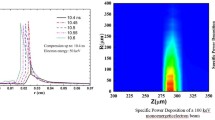Abstract
In this article we consider the problem of the stationary hypersonic flow of a viscous, heat-conducting stream of radiating high-temperature air past the forward critical point of a blunt body made of graphite in the region between a passing shock wave and the surface of the body.
We investigated the radiative and convective heat exchange taking place at an impenetrable surface, as well as such heat exchange when air is injected.
We obtained the characteristics of the graphite ablation on the assumption that there is radiative transfer of heat by the graphite-disintegration products.
The diffusion was calculated on the basis of a binary model, i.e., it was assumed that the mixture consists of two components: the advancing air and the disintegration products; the chemical reactions in the boundary layer were assumed to be frozen, and on the outer edge of the boundary layer, reaching out as far as the shock wave, they were assumed to be equilibrium reactions.
The condition of the gas on the disintegrating surface was also determined on the assumption that there was chemical equilibrium, and the saturation pressure of the vapors was assumed to be equal to the stagnation pressure.
It should be noted that the effect of ablation on heat exchange has been considered in [1–3]. Anfimov and Shari [1] assumed that pure air was injected and their calculations were carried out up to stagnation temperatures of 15·103° K. Hoshisaki and Zasher [2] gave an analysis of a small number of variants, where the values of the absorption cross sections of the injected components used in their calculations were independent of temperature; and the discussion in [3] was limited to the case of low injection velocities.
Similar content being viewed by others
Abbreviations
- cp :
-
specific heat at constant pressure
- ci :
-
mass concentration of the i-th component
- D12 :
-
coefficient of binary diffusion
- f :
-
dimensionless stream function
- h:
-
static enthalpy of the mixture
- hi :
-
enthalpy per unit mass of the i-th component
- k:
-
thermal conductivity
- mw :
-
total rate of mass loss through the surface
- p:
-
stagnation pressure
- q:
-
heat flux
- T:
-
absolute temperature
- u:
-
velocity component along the x axis
- v:
-
velocity component along the y axis
- τ:
-
optical thickness
- ϰ:
-
coefficient of absorption
- η :
-
Lees-Dorodnitsyn self-similar variable
- μ :
-
viscosity coefficient
- σλ:
-
absorption cross section
- ρ :
-
density
- σ:
-
Stefan-Boltzmann constant
- λ:
-
wavelength
- ϑ :
-
angle between the normal to the surface and the incident intensity ray
Literature cited
N. A. Anfimov and V. P. Shari, “Solution of the equations of motion for a selectively radiating gas in a shock layer,” Izv. Akad. Nauk SSSR, Mekhan. Zhidkosti i Gaza, No. 3 (1968).
H. Hoshisaki and Z. Zasher, Convective and Radiative Heat Transfer to an Ablating Body, AIAA Paper, No. 327 (1967).
A. B. Karasev and T. V. Kondranin, “The disintegration of graphite in a stream of low-temperature air plasma,” Zh. Prikl. Spektr.,2, No. 3 (1969).
C. F. Hansen, “Approximation for the thermodynamic and transport properties of high-temperature air,” NACA TR (1959), R-50.
J. Hirschfelder, C. Curtiss, and R. Bird, Molecular Theory of Gases and Liquids, Wiley (1964).
Yu. A. Plastinin, V. M. Nikolaev, and G. G. Baula, “Radiative and absorptive properties of air at high temperatures, T=2000–20,000°K,” All-Union Conference on Low-Temperature Plasma Physics, Kiev, 1966 [in Russian], Naukova Dumka (1966).
Yu. A. Plastinin, “The optical cross sections of absorption of diatomic molecules,” in: Physical Gas Dynamics of Ionized and Chemically Reactive Gases [in Russian], Nauka, Moscow (1968).
K. Wilson and W. Nicolet, “Spectral absorption coefficients of carbon, nitrogen, and oxygen atoms,” J. Quant. Spectrosc. Radiat. Transfer,7, No. 6 (1967).
Author information
Authors and Affiliations
Additional information
Translated from Izvestiya Akademii Nauk SSSR, Mekhanika Zhidkosti i Gaza, No. 1, pp. 23–31, January–February, 1971.
Rights and permissions
About this article
Cite this article
Karasev, A.B., Kondranin, T.V. The effect of ablation products on heat exchange in the disintegration of graphite in a radiating air plasma. Fluid Dyn 6, 20–28 (1971). https://doi.org/10.1007/BF01045902
Received:
Issue Date:
DOI: https://doi.org/10.1007/BF01045902




